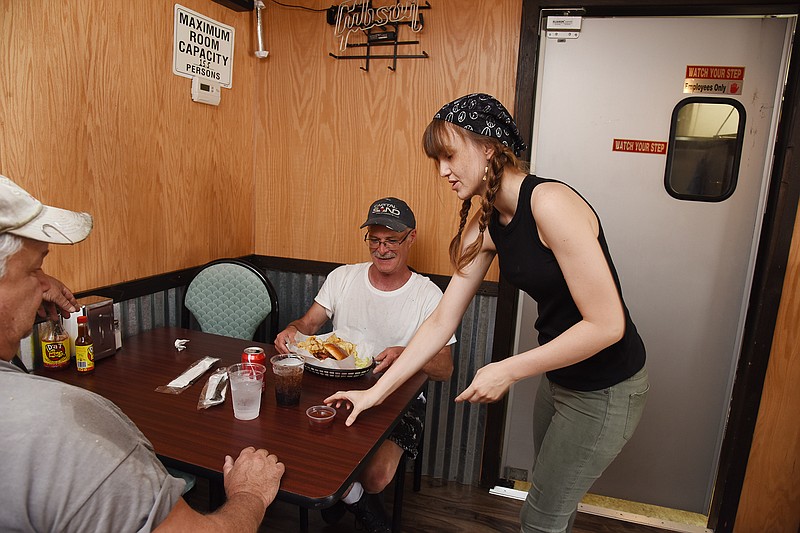Good customer service can make or break a business.
Communicating clearly with a customer can go a long way toward making sure a customer enjoys the visit and returns later, area restaurant and retail store owners say. Training staff members to be approachable and friendly also can go a long way toward creating repeat customers.
Researchers cautioned they don't fully understand the long-term effects that good customer service has on business.
#jcmo Inside Business
.Step 1: Be approachable
More than anything else, good customer service comes down to being approachable and appearing friendly, business owners told the News Tribune.
Downtown Book & Toy Manager C.C. McClure said smiling goes a long way.
"Some people like to talk with people and chit chat, or you don't," McClure said. "The people that do are most successful."
JQ's on High owner Quinten Rice said employees should show customers they care about their concerns.
"Ask questions, and be open and honest with whomever the customer is," Rice said. "That's the bottom line."
"The customer is always right, even if they're wrong."
Step 2: Remember the customer
On hectic days, it can be easy to forget about customers' individual needs. But business owners said employees need to slow down on those hectic days and try to take care of each individual customer.
Jerry Cowley owns Cowley Distributing, the company that owns Downtown Book & Toy on High Street and Downtown Book II and Play 2 Learn at Capital Mall. Employees can get bogged down in mundane tasks of running stores or restaurants, Cowley said. But customers like being recognized and feeling like they're part of the business, he said.
"Sometimes you forget that the number one thing you need to do is take care of the customer and that everything else will take care of itself," he said.
Chris Hilke, owner of The Pizza Company at 1508 E. McCarty St., said talking to customers as they leave is key.
"That's one of the big things," Hilke said. "When they come up to pay, make sure every customer is asked if everything tasted OK. 'Was everything all right?' If it's not, then fix it."
David Overfelt serves as the president of the Missouri Retailers Association, a Jefferson City-based trade group that represents retailers across the state. Employees and business owners represent themselves and their store when working with customers, Overfelt said.
"The customer is always right, even if they're wrong," Overfelt said. "They're the ones willing to dig into their pocketbooks to make a purchase."
"There are not bad employees; there's only bad managers."
Step 3: Spend time with staff
Managers at large and small businesses can impart personable skills on their staffs by spending time with the employees they supervise.
Annie Khmous and her husband, Mohanad, bought the IHOP franchise at 2011 Missouri Blvd. in May. The Khmouses relocated from Central Kansas to run the restaurant. She's been running IHOP restaurants for 19 years.
Since buying the restaurant, Khmous said, sales have been increasing. So she and her husband plan to hire more employees.
To become more familiar with her existing staff and new staff members, she tries to spend as much time as she can on the floor.
Working in a large restaurant like IHOP takes problem-solving and people skills, she said. Employees can be coached to do small things like smile and be polite while working with customers, Khmous said.
"There are not bad employees; there's only bad managers," Khmous said. "It's just about coaching."
Large retailers typically train employees by showing them videos and talking through scenarios using manuals. Training can differ by the level of retail experience and their positions within stores, Overfelt said.
Stores typically train all employees to work with customers, including people who stock shelves, because they realize all employees will interact with customers, he said.
"If you're in a store, customers are going to ask you for help regardless of what you're doing," Overfelt said.
He said retailing comes down to building trust between consumers and stores. With high turnover rates in hospitality industries, that trust can be especially hard to build.
In May, the unemployment rate for hospitality industries sat at 4.9 percent, according to the U.S. Labor Department. That tops the 3.8 percent overall unemployment rate but still sits at an extreme low for an industry notorious for its high turnover rates.
"Customer service can suffer somewhat because you're bringing in people who might have no experience with the public," Overfelt said. "It's hard to find people who want to work."
Step 4: Meet expectations
When entering a business, customers should have vision for what a business does and what services it offers.
At JQ's on High, Rice and his business partner John Johnson created a restaurant that celebrates music and Americana. The restaurant serves five types of pulled pork, a half-pound hamburger, baked beans and other general American fare.
As long as businesses communicate well with customers, Rice said, customers likely will be pleased.
"If they want a pizza, they should go to our friends at Prison Brews," he said. "If the business (communicates well), you should go home happy at the end of the day."
A 2010 study by the Customer Experience Leadership Council, a U.K.-based group that helps companies optimize the function of their businesses, found that trying to please every customer does not necessarily increase customer satisfaction. The study found customers are four times more likely to leave a business after a bad interaction with employees than after a positive one.
"Exceeding (customers') expectations during service interactions makes customers only marginally more loyal than simply meeting their needs," the study found. "Although customer service can do little to increase loyalty, it can (and typically does) do a great deal to undermine it."
"Word of mouth is always our best advertisement."
Step 5: Remember the double-edged sword of social media
Those in the restaurant and retail industries reached by the News Tribune say their efforts pay dividends by creating happy and repeat customers.
Research differs on the long-term impact of great customer service, though.
Often independent restaurants and retailers rely heavily on reputations partially crafted through social media. Rice said sites like Yelp and Google can help drive traffic to businesses with good reputations.
"Social media is definitely one of our biggest supporters because word of mouth is always our best advertisement," Rice said.
A 2011 study by the Harvard Business School found each star added on a Yelp review had a 5-9 percent effect on restaurants' revenues. These reviews largely did not affect the reputations of chain restaurants, but could help or hurt the reputations of small restaurants.
"That makes sense," Michael Blanding of the Harvard Business Review wrote, "since diners presumably already have some knowledge about chain restaurants, but can benefit from more information about their neighborhood spots."
Overfelt said online reviews typically help or hurt businesses that serve out-of-town customers the most.
"People look at that because they don't know where to go," Overfelt said.


